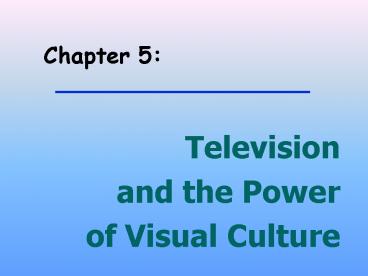Television - PowerPoint PPT Presentation
1 / 28
Title:
Television
Description:
... 'Spectaculars' (TV specials) with multiple sponsors. Quiz Show Scandals ... DISTRIBUTION of TV Shows. Networks send national programming to affiliate stations. ... – PowerPoint PPT presentation
Number of Views:128
Avg rating:3.0/5.0
Title: Television
1
Chapter 5
- Television
- and the Power
- of Visual Culture
2
Some guiding questions
- How did TELEVISION first develop?
- What was the role of sponsors?
- When was the Network Era of TV? How did it end?
- How are TV programs produced and marketed today?
- What is the role of TV in our culture and society?
3
Food for thought
- How does TELEVISION impact your daily life?
4
- What are some of the SOCIAL, CULTURAL, and
ECONOMIC factors surrounding the mass medium of
TELEVISION?
5
EARLY TECHNOLOGICAL DEVELOPMENTS
- Late 1800s cathode ray tube
- 1880s Nipkows scanning disk
- 1920s Zworykins iconoscope
- 1920s Farnsworths image dissector tube
- 1930 Farnsworth patented first electronic
television
6
Early TV broadcasting 1940s
- 1941 ten stations on VHF band
- 108 stations by 1948 (major cities only)
- FCC concerned about frequency allocation
- FCC FREEZE on new licenses 1948-1952
7
The Explosion of Television
- Soon after the FCC freeze was lifted in 1952,
over 400 television stations were in operation
8
SINGLE SPONSORSHIP
- Early radio and TV programs usually conceived,
produced and supported by one sponsor. - Shows were extended advertisements.
- Sponsors, not networks, had total control over
content.
9
The Collapse of Sponsorship How networks gained
control of programming
- Increased program length (raised production costs
for sponsors) - New concept of magazine programming, with sales
of spot ads - Introduction of Spectaculars (TV specials) with
multiple sponsors - Quiz Show Scandals (1958-1959)
10
What effects did the QUIZ SHOW SCANDALS have on
television and its audience?
11
NETWORK ERA of Television1950s-1970sNBC,
CBS, ABC
12
Changes in TV industry (late 1950s)
- Networks moved entertainment divisions to
Hollywood. - Network news operations (information divisions)
remained in New York.
13
TV and Information Culture
- Nightly news began in 1948.
- Modeled after radio news
- Primarily a verbal report by an authoritative
anchorperson - Images provided support
- 15-minute format
14
- What advantages did television news have over
newspapers or radio news? - What disadvantages?
15
TVs ENTERTAINMENT CULTURE THE GOLDEN AGE OF
TELEVISION
- Situation/domestic comedy
- Variety shows/sketches
- Anthology dramas
- Episodic drama series
- Continuing serials
16
- Which of these TV genres still exist today?
17
DECLINE OF THE NETWORK ERA
- TECHNOLOGICAL CHANGES
- GOVERNMENT REGULATIONS
- EMERGENCE OF NEW NETWORKS
18
TECHNOLOGICAL CHANGES
- Cable/Satellite TV services
- Non-network stations
- VCRs and home videos
19
- How did the VCR affect Americans television
viewing habits?
20
GOVERNMENT REGULATIONS
- Prime-Time Access Rule (PTAR), 1970
- Financial Interest Syndication Rules
(FIN-SYN), 1970-1995 - Justice Department ruling limiting networks
in-house production, 1975
21
Emerging New Networks
- FOX TV, 1987
- UPN (Paramount), 1995
- WB (Warner Brothers), 1995
22
ECONOMICS OF TELEVISION
- How are programs produced and distributed?
23
PRIME-TIME PRODUCTION
- Programs created by film studios and independent
production companies - Programs licensed to networks for a licensing fee
(for 2 airings) - Networks sell ad slots to advertisers
- DEFICIT FINANCING Production companies lose
money on network airing, but recoup it in
syndication
24
DISTRIBUTION of TV Shows
- Networks send national programming to affiliate
stations. - Each network has 150-200 affiliates.
- Network ownership of affiliates (OOs) was
limited by FCC. - Local affiliates sell local ad time.
- Affiliates have local control and choice.
25
SYNDICATION OF TV PROGRAMS
- Local TV stations and cable firms can buy
syndicated programs. - They acquire exclusive local market rights for
specific length of time. - Syndicated programs dominate hours outside prime
time (fringe time).
26
Types of Syndication
- Off-network
- First-run
- Hybrid
27
TV Ratings Systems
- Survival of programs depends upon whether
advertisers are happy with demographics of the
audience. - RATING statistical estimate of percentage of
households watching that program. - SHARE statistical estimate of percentage of
households with TVs turned on watching that
program.
28
Alternatives to commercial TV
- PUBLIC TELEVISION
- PUBLIC ACCESS TV
- E.g. Paper Tiger Television
- How could your voice and vision be seen and
heard?































